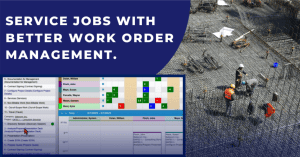Featured in Field Service News – Written By: Coen Jeukens, VP of Customer Transformation- ServiceMax
This article for Field Service News explains how to create a custom fitness plan to keep your assets in optimal condition. By using a comprehensive asset health management approach, supported by condition monitoring systems, you can develop a maintenance strategy focused on condition-based maintenance. This ensures your critical assets remain healthy and helps reduce unplanned downtime. With effective asset health procedures in place, you gain clear context on how each machine is performing at any given time, ultimately protecting your investment through real-time data collection.
Have you noticed your phone battery drains faster over time? Online forums are filled with tips for keeping your battery in peak condition. How does this apply to B2B products, equipment and assets? Can asset owners monitor equipment performance, and what controls do they have to maintain output at the promised level? These questions highlight the importance of monitoring asset conditions using real-time monitoring tools and predictive maintenance techniques. With plantwide asset health programs, you benefit from machine health insights for greater transparency. Data collection through condition monitoring sensors or solutions like monitoring explore orbit plays a key role in sustaining long-term operational success.
For many years, I’ve summarized the digital and service transformation journey in a single tagline: “from fixing what breaks to knowing what works.” The principle is simple: customers expect things to work. More importantly, they expect asset outcomes to remain stable throughout the lifecycle. Condition monitoring practices, whether through advanced systems or basic data-logging devices, help you use asset health data to maintain that stability. Adopting an asset health mindset provides clarity and insight into machine health, empowering processes that prevent issues before they cause failures or emergency repairs.
Everything eventually deteriorates and breaks. This leads to key questions:
- What is the life expectancy of the asset?
- What do I need to do to keep the asset in shape?
- What can I do to extend the asset’s lifecycle?
These questions emphasize the necessity for asset health maintenance and why asset management strategies rely on both health management (AHM) and condition-based maintenance (CBM). By combining real-time data from monitoring tools with predictive maintenance methods, you can better protect machinery, reduce unplanned downtime and maintain a proactive maintenance strategy.
Building a Fitness Plan
Preventive maintenance is often the first solution that comes to mind for keeping assets in shape. But what does preventive maintenance (PM) actually prevent? How does it affect asset performance and life expectancy? This question became challenging when a procurement colleague, aiming to reduce the cost of a service contract, asked, “What will happen if we reduce PM effort by lengthening the interval?” It was even harder when asked to prove the offset between PM and break-fix.
Where do we look next? I recommend condition-based maintenance.
Asset performance deteriorates over time, and the rate depends on attributes like aging and usage. These attributes are measurable, so they can trigger service interventions. This is where condition monitoring sensors, real-time dashboards and plantwide monitoring solutions highlight anomalies in machinery protection. Tools like “ranger pro” or software integrations such as explore orbit DCM or orbit march edition reports provide enhanced asset insights and help detect when an asset deviates from its nominal performance. This data is crucial to health monitoring and supports a real-time approach that prioritizes asset health improvements when needed most.
Instead of a one-size-fits-all approach based on time intervals, you can create a custom fitness plan for your assets. This plan considers the asset’s condition in relation to its expected performance. For example, an intervention is triggered when output or lubricant viscosity drops below a certain threshold. This plantwide asset health regimen clarifies exactly when to schedule maintenance tasks, minimizing guesswork and aligning with a condition-based maintenance philosophy.
Continuing the fitness metaphor, we don’t just want to stay in shape—we want to increase longevity and improve as we age. For assets, this means mid-life upgrades, booster packs and engineering changes. Just as you use predefined levers to trigger service interventions, use these levers to initiate updates, upgrades and lifecycle extensions. Systematic asset health interventions strengthen machine health and keep your maintenance strategy robust as assets age.
Both service strategies place asset health at the core of your delivery model, guiding you from ‘fixing what breaks’ to ‘knowing what works.’ Aligning real-time data from condition monitoring systems with predictive maintenance or health management ensures you remain proactive about machinery protection and unplanned downtime.
A Real Life Example
Imagine you have a pump and valve combination with a nominal capacity of 140 m3/h.
If you use a preventive maintenance model every 6 months, it won’t account for the age of the pump and valve or the corrosiveness of the materials transported.
But with a condition-based approach using IoT-connected sensors, you can measure vibration, temperature and energy consumption as indicators of asset performance. For example, if capacity drops below 130 m3/h, a service intervention is triggered. It’s like the pump saying, “I’m not feeling well, I need medicine.” If you detect the pump is consistently pushed beyond its original specifications, you know it’s time to initiate an upgrade discussion to maintain asset health and durability. Monitoring asset health this way provides a clear real-time view of performance, letting you use asset health data to further refine your management plan.
Asset Centricity
The common thread in these service strategies is asset centricity—putting asset health at the core of your service delivery and continuously comparing current output with expected performance.
By evaluating current performance, expected performance and demand, you can advise customers on when to downgrade or upgrade assets. With this asset-centric approach, you become a fitness coach, guiding customers on the right program to keep their assets in peak condition. A strong asset condition monitoring framework, combined with health management insights, ensures robust visibility at every stage of the asset lifecycle. Whether you use condition monitoring sensors, incorporate clarity in analysis or explore orbit to refine your data collection, this integrated approach upholds asset health maintenance and delivers true value.




